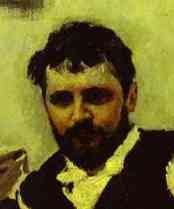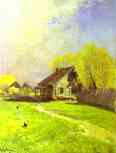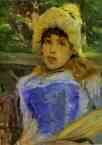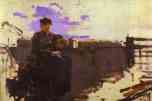Constantin Korovin Biography

Constantin Korovin was born in Moscow on December 5th, 1861 into the family of businessmen. His grandfather, a self-made man was the founder of the family business; his father, Alexey Mikhailovich, after graduating from the University had to go into business as well, though he never liked it and was more interested in art and music. As a result, soon after the grandfather’s death the family went bankrupt and had to move into the country. Constantin and his younger brother, Sergey, also a future artist, were brought up in an artistic atmosphere, they received drawing and painting lessons since their childhood.
In 1875, Constantin entered the Moscow School of Painting, Sculpture and Architecture, among his teachers were I. Pryanishnikov, E. Sorokin, V. Perov, and A. Savrasov. “These fair and kind teachers left deep traces in my soul. They are all dead now; and I remember them with admiration and a sad love; they seem alive, before me, these pure and honest people…” At School Korovin became friends with I. Levitan.
In 1881-1882, Korovin spent a year at the Academy in St. Petersburg, but returned disappointed to Moscow. That year a new professor came to the Moscow School, a distinguished painter Vasily Polenov, who impressed his students not only with his painting but also with his knowledge and enthusiastic attitude towards contemporary Western art, especially French. Korovin stayed with the new teacher at the Moscow School until 1886. Polenov introduced his student to the famous patron of arts Savva Mamontov and his Abramtsevo group. The group included artists who favored the school of national romanticism in Russia. They were the first in the country to stage operas, produce experimental architectural works and design books in the new (‘neo-Russian’) style. They projected the image of a universal artist: painter, furniture and tableware designer, designer of stage costumes and settings, architect. With Polenov’s recommendation S. Mamontov invited Korovin to work for his private opera. Thus Korovin got engaged with theatre, for which he worked till the end of his life. Korovin was the first to introduce the Impressionist style on stage.
In 1885, Korovin made his first of many trips to Paris and Spain. “Paris was a shock for me… Impressionists… in them I found everything for what I was scolded back at home, in Moscow.” In 1888, Korovin traveled with S. Mamontov to Italy, then visited Spain, where he painted one of his best works In Front of the Balcony: Leonora and Ampara. The artist traveled widely within Russia, Caucasus and Central Asia, exhibited with the Itinerants’ Society of Traveling Exhibitions (“Wanderers”), painting in an Impressionist and later an Art Nouveau style.
In the 1890s, Korovin became very active in the World of Art group (“Mir Iskusstva”). These artists adopted a new aesthetic approach to the world’s artistic heritage; they popularized the traditions of folk art and of Russian art of the eighteenth and early nineteenth centuries.
In 1896, Korovin designed, to great acclaim, the pavilion of the All-Russian Exhibition of Arts and Crafts at Nizhnii Novgorod. In 1900, he designed the decorations for the Central Asia section of the Paris World Fair; the same year he was awarded the Legion of Honour.
At the beginning of the twentieth century Korovin began to take a more close interest in the theatre. Working for the Bolshoi theatre he upheld new principles in designing operas and ballets. His evolution as a stage artist is directly linked to his mature painting. The peculiar features of the Russian Impressionist school became increasingly pronounced in his works of this period: the predilection for decorative effects, the emphatically expressive coloristic solutions and the pronounced romantic note. Korovin’s subjects were quite diverse, they included townscapes and rural landscapes, portraits and still lifes.
The first years of the 20th century were undoubtedly the peak of his creative career. In 1905, Korovin received the title of the Academician of Painting, and in 1909-1913 taught at the Moscow School of Painting.
In 1923, Korovin left Russia never to return. He spent the last 15 years of his life in France supported by Shalyapin, he worked for theatre as a stage designer. He also became famous as a book illustrator, but this period is obviously inferior to his former achievements.
The artist died on September 11th, 1939 in Paris. Constantin Korovin always protested against attempts to place him into any artistic school or movement. Nevertheless he became the first Russian Impressionist painter, moreover, he was the creator of the national variant of this International school.
Bibliography
Constantin Korovin. New Gallery, 20th Century. By A. Gusarova. M. 1990.
Constantin Korovin Remembers… Moscow. “Izobrazitelnoe Iskusstvo”. 1990.
- In Front Of The Balcony: Leonora And Ampara.

1888-1889. Oil on canvas. The Tretyakov Gallery, Moscow, Russia.
- Early Spring.

1870s. Oil on canvas. The Tretyakov Gallery, Moscow, Russia.
- A Picnic.

1880. Oil on canvas. The Tretyakov Gallery, Moscow, Russia.
- Portrait Of A Chorus Girl.

1883. Oil on canvas. The Tretyakov Gallery, Moscow, Russia.
- On The Road.

1885. Study. Oil on canvas mounted on cardboard. The Tretyakov Gallery, Moscow, Russia.